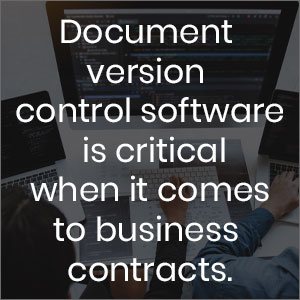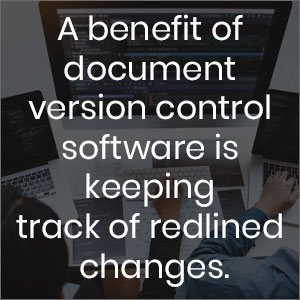Who has not sent an email without the attachment that we meant to send or – worse yet – an earlier version of a document that a customer, executive, or attorney requested that you modify?
Indeed, to err is human, and to deploy contract lifecycle management (CLM) software is divine. And that includes the control functionality that a CLM typically offers. Without it, how else would you manage important business agreements – from creation to close? Have the author add to or revise contract versions manually, and hope that the other party to the agreement does not change the file naming convention or the file order somewhere along the way? Cross your fingers that you do not drop the contract into the wrong customer folder or skip a version altogether?
Document version control is not new; it has always been critical that you manage versions efficiently and effectively when it comes to business contracts. These include HR agreements, supplier contracts, and memorandums of understanding. But although document storage applications, like SharePoint or OneDrive, have such version control functionality, those applications lack the rigor required for contract management – not to mention the tightly integrated contract assembly, workflow, review, and analysis capability of a true CLM system.
Contract Management Systems
Let’s face it, there is something deeply satisfying about an advanced contract management system (CMS) that enables you to take a step back in the contract review lifecycle; peer into a contract’s history, and reuse a clause that you would have to rewrite without revision control.
If someone creates a new version of an agreement, you can see exactly who that was in the audit trail. Once negotiations are wrapped up, and the final document approval workflow is completed, a privileged contract administrator can declare a signed agreement as to the contract of record. All parties must live up to this or reckon
Document version control software is critical when it comes to business contracts
with the terms identified in the contract’s termination language. If any document is approaching its expiry period, needs renewal, or requires editing, it is looked at by the document management team.
DOCUMENT VERSION CONTROL SOFTWARE IN A CRISIS
Depending on the pace of your business and the magnitude of a crisis, such as the COVID-19 pandemic, there are bound to be errors – and a scramble to get business deals closed as soon as possible before they fall apart.
For an innovative, high-growth company like IPsoft, however, sophisticated document version control functionality was more than a ‘nice-to-have’ feature. It was mission-critical in the middle of a crisis. And it will remain as such when the current circumstances become the new normal.
TAKING THE GUESSWORK OUT OF VERSION CONTROL
Of course, it does not take a crisis for an important version of a legal document to be renamed or saved over. But it certainly increases the likelihood of both happening. This is particularly problematic when document versions, associated comments, and redlines are required as evidence in a court case or needed in an audit.
Documents and contracts are usually referred to as a “living document,” meaning it is subject to change until they are approved, signed, and declared as a record.
A benefit of document version control software is keeping track of redlined changes. Before final, signed versions, CLM software automatically identifies version milestones, such as those marked in personal lives. (But you do not have to make a cake or buy presents for document versions!)
BENEFITING FROM DOCUMENT VERSION CONTROL SOFTWARE
To recap, the primary benefits of version control functionality are:
- Keeping documents – including Word documents, Excel spreadsheets, and paper files that have been scanned and converted to PDFs – in their original format and filing them in appropriate folders
- Establishing and maintaining consistent document naming conventions
- Keeping track of redlined changes, comments, and discussions about a contract to meet audit requirements
- Instilling confidence in your company and other parties to your contracts because of transparency
- Comparing documents to see if changes were made without proper redlining
- Keeping an audit trail of who made changes to a contract
- Safeguarding individual documents from being saved over
- Providing visibility into a contract’s evolution to expedite future contract negotiations. Or, identify how terms were clarified or changed to get an agreement signed
So, do you need a true end-to-end contract lifecycle management solution – one that enables your business to work collaboratively with your suppliers throughout negotiations? Do you want to minimize the delays or distractions caused by clumsy manual version control? Read our Express Contract Collaborator datasheet today. Discover the essential functionality that you need to better control your contract lifecycles.










